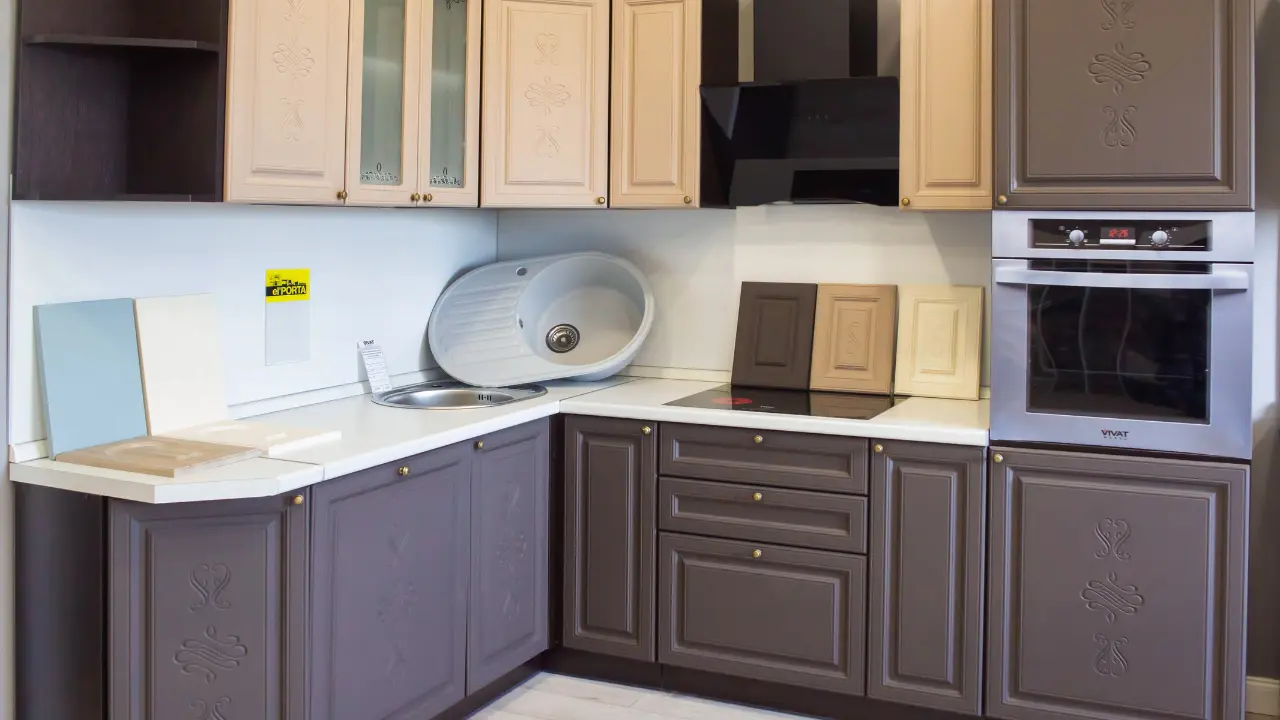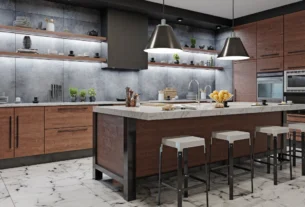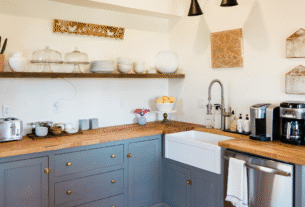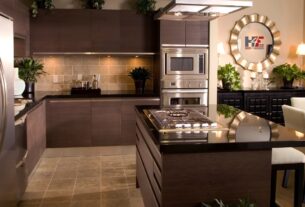As Indian lifestyles evolve, modular kitchen design ideas are gaining prominence across the country. Unlike traditional kitchens, modular kitchens are manufactured, pre-fitted units that offer convenience, customization, modern aesthetics, and smarter use of space. In 2025, rising urbanization, shrinking living areas, and growing digital-savvy populations are driving the rise of modular kitchen concepts—from high-end apartments in Mumbai and Delhi NCR to compact homes in tier-2 cities.
Whether you’re redesigning your cooking space or planning a new home, modular kitchens provide a balance of style, efficiency, and ergonomics tailored to Indian household needs.
Understanding Modular Kitchen Basics
At its core, a modular kitchen is composed of standardized cabinets, shelves, drawers, and fittings pre-made in factories and assembled on-site. This system enables precise dimensions, high-quality finishes, and faster installation. In the Indian context, modular kitchens are designed to accommodate traditional cooking practices like over-the-counter burners, tandoors, and pressure cookers while integrating modern amenities seamlessly.
Why modular kitchens resonate with Indian homes:
- Better space utilization in narrow or L-shaped layouts.
- Custom zones for gas stoves, chimneys, sinks, and storage.
- Integration with electrical, plumbing, and IoT elements.
- Stylish adaptability for different budgets—from minimalist Scandinavian-inspired designs to opulent wood and brass setups.
Trending Design Styles (2025 Edition)
Scandinavian Minimalism with Indian Warmth
Scandinavian design, known for its minimalism and functionality, is now fused with Indian warmth. Clean white cabinets, light oak interiors, and matte black hardware are paired with handwoven rattan panels or brass knobs inspired by Indian crafts. Floating shelves with mango wood add a rustic charm while maintaining functional storage.
Matte-Finish Monochromes
Deep hues like matte navy, charcoal grey, dusty green, or muted mustard are trending for a premium look. Complementing these shades are metallic trims—brass or copper—adding contrast and elegance. These palettes offset Indian cooking’s occasional clutter, providing a sleek backdrop.
Eco-Friendly Natural Modules
Sustainability is a growing priority. Modular units crafted from bamboo plywood, recycled wood composites, or recycled plastic are becoming widely popular. These eco-materials, treated for Indian humidity levels, are ideal for backsplashes or pantry units without compromising on aesthetics.
Fusion of Vintage and Contemporary
Retro-inspired tile backsplashes—think Madhubani or Blue Pottery motifs—paired with sleek shaker-style cabinets create a charming fusion. Brass pendant lights with Indian motifs like peacocks or paisleys elevate aesthetics while lighting up work zones.
Open-Concept Glass and Steel
In urban Indian homes with open layouts, glass-front and steel-frame cabinets act as display units without overwhelming the visual flow. Smart lighting inside these units highlights crockery and décor, blending utility with display.
Layoutes Tailored for Indian Cooking Culture
L-Shaped Convenience
A practical layout for Indian kitchens is the L-shape, offering compact triangle access between stove, sink, and fridge— ideal for one or two helpers. Modular elements like corner pull-out cabinets and rotating carousels maximize storage efficiency.
Parallel (Galley) Style
Perfect for small flats, this type aligns utilities on two facing walls. With modular design, you get sleek cabinetry, hidden exhaust ducts, and retractable cutting boards, making movement smooth and functional.
U-Shaped Kitchens
For homes with more space, U-shaped layouts include a central island or countertop serving as an additional zone for prep or breakfast. These are perfect for large Indian families or open-plan homes, enabling multiple cooks or entertainers in the kitchen.
Island-Centric Kitchens
The island—not just an aesthetic element—becomes a workspace, storage unit, and even casual snack bar. Modular islands with waterfall countertops are rising stars in luxury urban homes seeking both function and style.
Smart Integration and Tech-Friendly Designs
Voice-Activated Lighting and Appliances
In modern Indian homes, kitchens blend ergonomics and automation. Voice-activated overhead lighting, sensor-controlled faucets, and app-enabled cooktops make cooking hygienic and convenient—particularly useful when hands are messy or busy.
Hidden Appliances
Pop-up electrical outlets for mixers or blenders, pull-out pantries with sliding dispensers for grains, and appliance garages increase usability while maintaining uncluttered visuals.
IoT-Enabled Features
Smart refrigerators that monitor inventory, smart chimneys that auto-adjust suction, and water purifiers with app integration are now integral in modular designs, enhancing efficiency and user experience.
Ergonomics and Storage Solutions
Pull-Out Mechanisms
Deep drawers with cutlery trays, pull-out corner shelves, and toe-kick drawers for buckets and cleaning supplies are engineered to Indian cooking preferences and daily routines.
Accessory Integration
Modular kitchens now come with plate racks, knife blocks, spice racks, and dedicated tawa or thali storage—all integrated for easy pull-out access, reducing clutter.
Elevated Cabinets
For homes in India, elevated wall cabinets reduce bending and improve ergonomics, especially beneficial for older users or those with mobility constraints.
Material Highlights for Indian Homes
Granite and Quartz Countertops
Quartz and granite remain popular due to their heat and stain resistance—important factors in Indian kitchens with heavy cooking and spices.
Durable Backsplashes
Tiles—like ceramic ikat prints, high-pressure laminates, or tempered glass with embedded designs—balance aesthetics with practicality for easy cleaning.
Hardware That Lasts
Soft-close hinges, powder-coated handles, and anodized aluminium frames resist Indian humidity and frequent use, ensuring longevity.
Customization by Budget Tier
Entry-Level Solutions (~₹1–2 lakh)
Use of laminate or MDF with laminate finishes, basic under-sink setups, and standard BIFMA hardware. Ideal for first flats or affordable housing.
Mid-Range Designs (~₹2–5 lakh)
Incorporates eco-materials, integrated appliances, better lighting, and more customization, suitable for growing urban families.
Luxury Assemblies (₹5 lakh+)
High-end materials like solid wood veneer, smart systems, islands with quartz countertops, and bespoke lighting offering both statement aesthetics and performance.
Indian Cooking Needs & Design Adaptations
Indian cooking styles are heavy on spices, steam, and vigorous use. Modular kitchens must accommodate these nuances:
- Chimney-integrated exhausts ensure efficient smoke removal.
- Heavy-duty drawer sliders and hinges are essential for frequent use.
- Segregated wet and dry zones prevent cross-contamination and facilitate cleanup.
- Spice organization systems with vertical racks or pull-outs maintain functionality.
- Fire-resistant backsplash helps with flame-heavy stovetops.
Case Studies – Real Homes, Real Impact
Mumbai Apartment – Compact 60 sq. ft Setup
An L-shaped modular kitchen with matte teak laminate, pull-out drawers, and LED strip lighting under cabinets offered functionality and bright visuals—turning a compact space into an efficient culinary zone.
Pune Villa – Eco & Artisan Mix
A U-shaped layout with bamboo plywood modules, decorative Madhubani backsplash, and brass floral hardware gave this home an eco-sensitive yet culturally rich identity.
Bengaluru Luxury Flat – Smart Minimalism
Featuring monochrome navy cabinets, a floating quartz island, hidden appliances, and touch-controlled lighting, this flat merged smart tech with modern minimalism seamlessly.
Maintenance Tips for Longevity
Maintaining modular kitchens in India needs awareness:
- Use microfiber cloths and mild detergent for countertops and cabinets.
- Descale taps and sinks owing to hard water in many regions.
- Re-lubricate hinges and sliders every year to combat humidity.
- Ensure chimney filters are cleaned monthly to maintain air quality.
- Seal wooden edges and joints periodically to prevent moisture damage.
Choosing the Right Vendor: Checklist
When selecting a modular kitchen vendor:
- Prioritize providers offering site measurement, CAD layout, and 3D mock-ups.
- Insist on OEM or branded hardware (Hettich, Hafele, Grass).
- Check for warranty on hardware and installation.
- Evaluate load-bearing strength—especially for overhead cabinets.
- Review post-installation services for adjustments and upkeep.
Cost vs Value: What You Should Know
While modular kitchens are costlier upfront than simple carpentry, they offer:
- Longer durability and easier maintenance.
- Higher space efficiency.
- Better resale value—buyers often prefer homes with modern kitchens.
- Reduced labor costs due to faster installation.
- Sharper design aesthetics aligned with contemporary living.
Outlook: What’s Next in 2025+
Several emerging trends promise to shape Indian modular kitchens:
- 3D printed cabinetry prototypes for rapid customization.
- Augmented Reality (AR) design tools helping homeowners visualize layouts before buying.
- Self-cleaning surfaces with nanotechnology.
- Solar-integrated countertops that help preheat water for kitchen use.
Conclusion
If you’re contemplating a modern upgrade or starting planning a new home, modular kitchen design ideas hold the key to combining the best of form and function. Whether your priority is efficient storage, smart integration, cultural accents, budget-friendliness, or sustainability, versatility is the hallmark of modular kitchens.
As India’s living patterns evolve through 2025, modular kitchens are not just design choices—they’re future-ready home investments.






